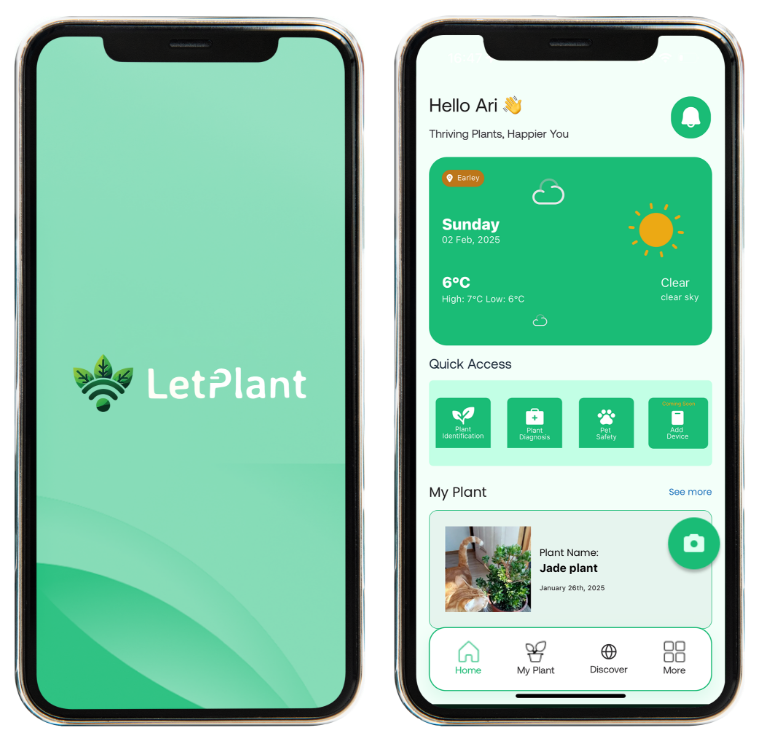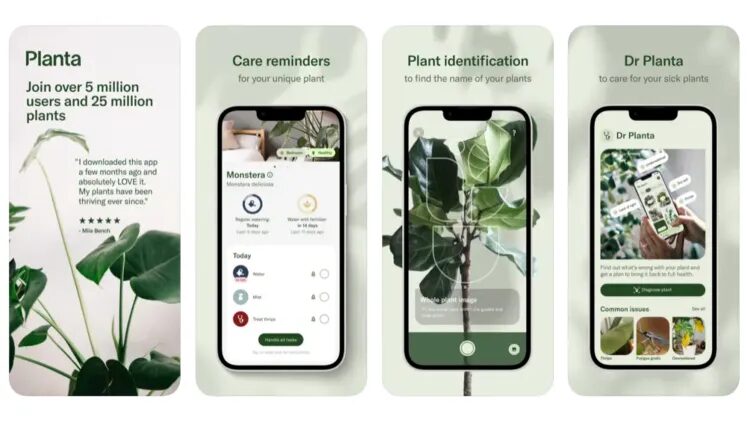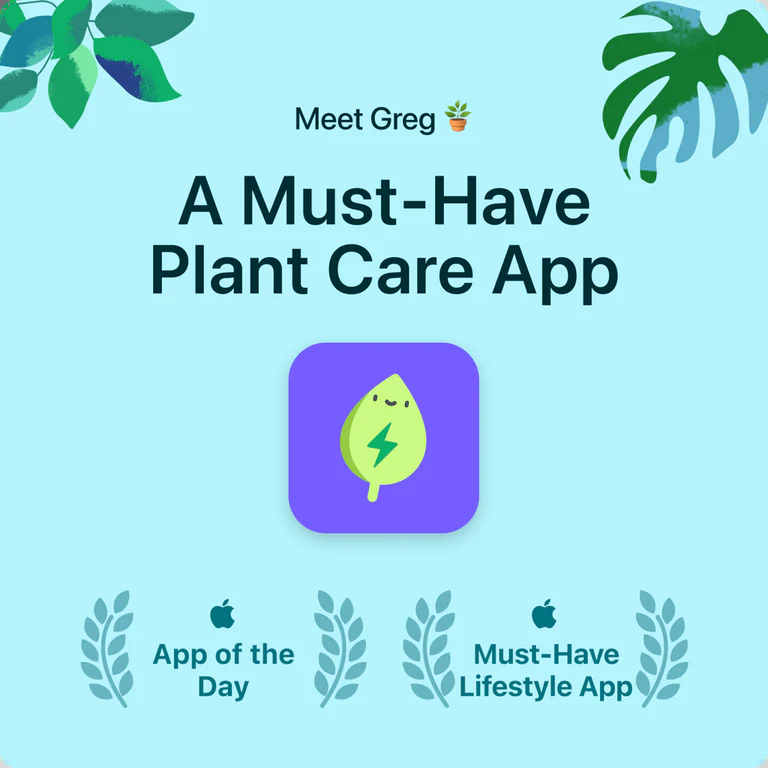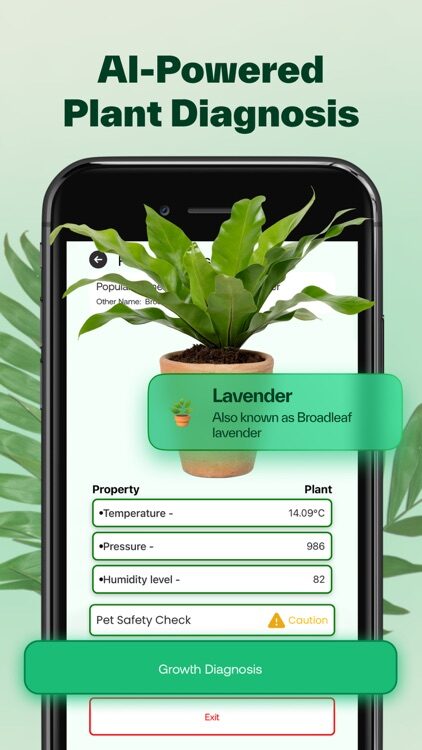A wave of smart gardening apps is transforming how urban dwellers care for houseplants, marrying technology with eco-friendly practices.
Indoor gardening surged in popularity during the pandemic, and technology stepped in to help novice “plant parents” keep their greenery alive (cool apps and gadgets help plant parents nurture their green babies better — Times of India).
In 2025, sustainability is at the forefront of this trend, with apps providing guidance on water conservation, smart scheduling, and even enhancing indoor air quality.
We look at three of the top planting apps:
1.LetPlant
2.Planta
3.Greg
They are shaping a more sustainable indoor gardening experience.
The rise of smart indoor gardening
Houseplant ownership has become more than a hobby—it’s a lifestyle shift towards bringing nature into homes and promoting well-being. Millions have turned to digital tools for guidance, leading to a boom in plant care apps that monitor watering needs, light, and soil conditions (cool apps and gadgets help plant parents nurture their green babies better—Times of India).
These apps serve as personal gardening assistants, using databases and AI to tell users when to water, how to diagnose yellowing leaves, and ways to keep plants healthy.
Crucially, they also align with eco-conscious values: by preventing overwatering and plant loss, they help conserve resources and encourage greener living.
Sustainability is a key theme.
Garden experts note that 2025’s plant trends emphasise eco-friendly care—from choosing low-water plants to using technology for efficient irrigation .
Smart apps tap into this potential by tailoring care to each plant’s needs and environment, ensuring minimal waste.
As Andrew Bunting of the PHS Gardening Society says, gardening is increasingly about “eco-conscious practices” and reconnecting with nature in creative ways. Whether one has a single potted fern or an indoor jungle, today’s apps aim to make plant care both easier and more sustainable.
Below, we explore the top three apps leading this green tech revolution:
LetPlant – AI-Houseplant care with a sustainable twist

LetPlant: AI Houseplant Care by LetPlant Technology Ltd LetPlant’s app uses AI for plant diagnosis and even flags pet-toxic plants, offering a high-tech approach to eco-friendly indoor gardening.
Emerging as a cutting-edge contender,
LetPlant leverages artificial intelligence to turn any home into a “thriving green sanctuary,” as its creators put it . Launched in 2024, this London-based app distinguishes itself with a comprehensive feature set and a strong sustainability ethos.
Advanced AI algorithms enable instant plant identification and smart diagnosis of issues — users can snap a photo of a drooping leaf to get an analysis of possible pests, diseases, or nutrient deficiencies and how to fix them.
What truly sets LetPlant apart is its focus on proactive, data-driven care. The app provides personalised care plans for each plant by adjusting watering schedules, ideal lighting levels, and temperature ranges to suit the species.
This means no more guessing how often to water the fern or if the ficus is getting enough sun — LetPlant’s recommendations aim to give every plant just what it needs. An upcoming addition, a smart sensor system called LetPlant SDESA, will offer real-time monitoring of soil moisture, light, and temperature, feeding data into the app to alert users before problems arise.
See LetPlant: AI Houseplant Care in the App Store
By continuously tracking conditions, LetPlant helps prevent overwatering or neglect, which keeps plants healthier and avoids wasting water or resources.
Beyond plant care basics, LetPlant has a unique pet safety checker to identify plants that are poisonous to cats or dogs—a thoughtful feature for sustainable homes with pets and plants coexisting.
Its extensive plant library highlights which plants purify air or are low-maintenance, aligning with the app’s goal of creating healthier indoor environments. In fact, indoor air quality is a selling point: LetPlant encourages growing certain greenery that “effectively removes CO₂, improves air quality, and creates a healthier living space.”
This nod to climate benefits, using plants as natural air purifiers, underlines LetPlant’s sustainability angle.
LetPlant’s commitment to green living is also evident in its company mission. “We are transforming the way people interact with their plants… providing tools to ensure their plants’ health and longevity,” says Tolu, the founder of LetPlant.
By integrating tech and nature, LetPlant aims to contribute to “a greener, more sustainable urban environment,” not just individual plant success In practical terms, that means urban gardeners can maintain vibrant indoor gardens with less waste: the AI minimises common errors like overwatering Healthy plants live longer, reducing the cycle of replacing dead plants.
Early users praise LetPlant’s all-in-one approach — from its slick interface to the responsive AI assistant.
While relatively new compared to its rivals, LetPlant is quickly earning a reputation for innovation in sustainable plant care. Its strengths lie in automation and foresight: it doesn’t wait for a plant to wilt to act but rather helps users anticipate needs.
For those passionate about technology and the environment, LetPlant stands out as a forward-thinking gardening companion.
A potential drawback is that some advanced features (like the smart sensor) are still rolling out, and its plant database is growing. However, with free core features and a community forum for support, it offers plenty even to beginners.
Overall, LetPlant’s AI-driven, sustainability-focused model is redefining what a gardening app can do — making it more than a scheduler but a catalyst for greener living inside our homes.
Planta – A veteran app with smart scheduling and guidance
 Planta has a large user base and provides customised care reminders (water, fertiliser, mists, etc.), helping millions of people keep their houseplants thriving.
Planta has a large user base and provides customised care reminders (water, fertiliser, mists, etc.), helping millions of people keep their houseplants thriving.
For a few years now, Planta has been the go-to app for many indoor gardeners, renowned for its reliability and breadth of features.
This Swedish-developed app, used by over 7 million plant enthusiasts worldwide, bills itself as an all-in-one plant care assistant. Its formula for success? Smart scheduling and user-friendly guidance that take the guesswork out of plant care.
Once a user inputs their houseplants (either by searching Planta’s database or using the built-in identification tool), the app generates personalised care plans—including when to water, fertilise, mist, prune, and repot each plant.
Timely reminders pop up so you don’t forget these tasks, essentially turning your smartphone into a gentle nagger for your fiddle-leaf fig.
Planta’s scheduling is impressively intelligent.
The app’s algorithms juggle over 30 factors—from plant species and pot size to seasons and local weather—to decide the perfect time to water your plant. It even pulls in local climate data to adjust watering reminders based on humidity and rainfall.
This means if you’re in a rainy week or a humid summer, Planta might delay watering prompts, conserving water and preventing overwatering. Such optimisation directly supports sustainability by aligning care with real conditions and ensuring plants get only what they need. “Know exactly when it’s time to water your plant” is a core promise, and it extends to other care aspects too.
For example, if winter’s low light slows growth, Planta might reduce how often you fertilize. This data-driven, waterwise approach helps avoid waste—an eco-friendly improvement over rigid weekly watering schedules.
Another strength is Planta’s “Dr Planta” feature, essentially a digital plant doctor that can diagnose common issues like yellow leaves or pests. damage. By answering a few questions or snapping a photo, users get possible causes and treatment suggestions for their ailing plant.
Early detection and cure of problems mean fewer plants end up in the bin, which is a subtle sustainability win (less plant replacement and less use of chemical pesticides when issues are managed promptly).
Planta also includes a light meter tool to gauge if a spot in your home has suitable light for a plant, guiding users to place plants in optimal locations — indirectly ensuring healthier growth with minimal intervention.
Community and content add to Planta’s appeal.
The app has an active community forum and social feed where users share tips, photos, and successes, creating a space to learn from others. There’s also a rich library of plant care articles and step-by-step guides accessible through the app.
These resources often include eco-friendly gardening tips, such as how to propagate cuttings (to grow new plants sustainably) or clean dust off leaves to improve photosynthesis.
Planta’s developers seem conscious of green practices—even the app’s reminders encourage moderation (water only when needed, fertilise during the growing season, etc.), reinforcing habits that align with conserving resources.
As a mature platform, Planta is polished and comprehensive.
Users appreciate its intuitive interface and the peace of mind that no plant will be forgotten. “I absolutely LOVE it… My plants have been thriving ever since,” one user review notes, reflecting common sentiment. However, being a veteran comes with some trade-offs. Many of Planta’s best features require a premium subscription — the free version covers basic watering reminders and a few plant IDs per month, but advanced tools like unlimited identifications, detailed care schedules, and the Dr. Planta diagnosis are behind a paywall.
While the cost (around $35/year) is justified for serious enthusiasts, casual gardeners might stick to the free tier’s basics. Another minor drawback is the schedule’s rigidity; if you water a bit early or late, you may need to manually adjust the reminder, whereas more adaptive systems (like LetPlant’s AI or Greg’s dynamic model) handle that automatically. Furthermore, Planta’s focus is mainly on planned care tasks; it doesn’t incorporate real-time sensor data or hardware integration.
That said, Planta’s strengths lie in its proven track record.
Planta serves as a robust digital coach for plant care routines, providing users with a wealth of knowledge through its proven track record. For someone who has a large collection of houseplants or multiple species to manage, Planta offers structure and organisation; you can even group plants or “share” care duties with your family via the app.
Its contribution to sustainability comes through consistency: by helping millions “keep their plants alive”, Planta reduces the common cycle of plant replacement (and the associated waste of money and materials) and promotes the joy of cultivating long-lived plants.
In short, Planta remains a top pick for all-round plant care, seamlessly blending tech convenience with horticultural wisdom—a combo that ultimately leads to greener homes and happier plant owners.
Greg – Cultivating a community and watering smarter

Greg’s friendly leaf icon represents its mission: a must-have app using science and community to make plant care fun and effective.*
If Planta is the seasoned instructor and LetPlant the high-tech innovator, Greg is the community scientist among plant care apps.
Launched in 2020, Greg quickly gained a following thanks to its approachable style and focus on precise watering through science.
The app aims to provide “zero-guesswork plant care,” primarily addressing the age-old question: How much and how often should I water my plant? Greg’s answer is delivered through a blend of botanical science, machine learning, and social networking.
At its core, Greg customises a watering schedule for each plant you own. It asks for your plant’s species, pot size, and location (including how far it sits from a window) and then computes an optimal watering plan .
The technology that powers this system is notably rigorous: Greg’s algorithm is built on the UN Food and Agriculture Organization’s Penman-Monteith equation—a standard model for predicting plant water needs based on it.
In simple terms, the app calculates how quickly water evaporates from soil and how much the plant is using, considering factors like temperature, light intensity, and humidity. It even accounts for “Earth-Sun orbital dynamics”—meaning seasonal day length and weather shifts at your specific location.
All this data crunching yields a highly tailored schedule; one plant might need 1 cup (0.24 l) of water every 10 days, another 2 cups (0.47 l) every 5 days, etc., and Greg will tell you exactly when and how much to water each one.
The sustainability benefit of Greg’s approach is clear: by watering “exactly” as needed, users avoid overwatering (a common mistake that wastes water and drowns plants) and under-watering (which can kill plants).
Greg explicitly markets that you’ll “never overwater again” with its precision guidance. This water-efficient method helps conserve one of our most precious resources while keeping plants healthier. It’s essentially applying smart irrigation principles—often used in agriculture— to houseplant care. Users have reported that following Greg’s calculated reminders has improved their plants’ vitality and cut down water use compared to arbitrary routine watering. In an era of increasing water consciousness, this feature alone makes Greg a valuable tool for eco-minded gardeners.
Yet Greg is not just about algorithms; it has a distinctly social side. Upon joining, users become part of a global community of plant enthusiasts (the app’s creators, Gregarious Inc., are fittingly a Public Benefit Corporation focused on community building).
Greg’s home screen includes a social feed where people post photos of their plants, share updates (“My monstera grew a new leaf!”), or ask for help with issues. Within these in-app communities (often tagged by plant type or interest), newbies can get near-instant advice from veteran “plant parents”
For example, if someone’s fern is getting brown tips, they can post a question and others will chime in with answers, much like a friendly online gardening club.
This crowdsourced support not only spreads practical knowledge (often including organic care tips or creative reuse ideas) but also fosters a sense of solidarity in nurturing nature — which resonates with sustainability values of learning and sharing for the greater good.
Greg also offers a bit of gamification and tracking.
Users earn experience points (XP) for caring for plants, can level up, and even compare progress. Each plant gets a profile that shows statistics, like how long it has been since it was last watered, how much water was given, and growth milestones .
This history helps users become more attuned to their plants’ cycles over time. While Greg initially focused almost entirely on watering, it has gradually added features: it can identify plant species via the camera (called PlantVision), and it provides basic light-level guidance and fertilisation tips in its content.
However, it still does not have the full suite of care reminders that Planta has — for instance, it won’t explicitly remind you to mist or repot (as of 2025). Its philosophy is somewhat “water-first,” on the premise that watering is the most critical aspect of plant care for beginners to master. Some advanced growers might find this limiting, but Greg’s developers hint at more features to come.
The user experience on Greg is often described as fun and encouraging. The interface is bright and simple, with a mascot-like leaf icon and casual language. Greg emphasises that by using the app, “you also join a global community… and stay reminded of how interconnected we all are on this big, beautiful planet of ours.” This community ethos, blending environmental awareness with social connection, gives the app a friendly personality. In reviews, users credit Greg for saving their once-struggling plants and turning them into confident caretakers. “ This app is a literal life saver for my plants,” one user wrote, while another joked, “I’ve killed every plant I touched before – Greg is precisely what I needed!”
In terms of limitations, Greg operates on a freemium model: it’s free to use for a limited number of plants (often up to 5), after which a subscription is required for more plants and certain premium insights. The paid tier (sometimes branded “Super Greg”) unlocks detailed metrics like precise water volume suggestions and an indoor light gauge feature.
For most casual users with a handful of plants, the free version is sufficient to get tailored schedules and participate in the community.
Another potential downside is that Greg’s focus on watering means you might need to supplement it with your calendar or another app for tasks like fertilising or pest control alerts. The developers’ partnership with experts (for example, Houseplant Journal’s Darryl Cheng collaborates with Greg to infuse science-based tips) suggests the app will continue to improve its holistic care offerings.
Overall, Greg shines in its niche: it brings sophisticated agricultural science to the lay gardener in a digestible way and wraps it in a supportive social network. Greg provides a satisfying educational angle for users who value precision and understanding why their plant needs what it does. Its contributions to sustainability are tangible—efficient water use and a thriving community that promotes sharing resources (like plant cuttings, swaps, or advice to use organic fertilisers).
Greg may not (yet) do everything, but what it does, it does exceptionally well. It’s an ideal choice for those who want a data-informed approach to plant care and enjoy connecting with fellow plant lovers. In the Garden of Apps, Greg is helping a new generation of gardeners grow not just plants but also knowledge and community—cultivating a greener future, one drop of water at a time.
Sustainability at the root: Water-wise and eco-friendly features
All three apps share a common goal: making plant care easier and more sustainable for indoor gardeners. A major theme is water conservation. These apps address overwatering, a common mistake that damages plants and wastes water. Planta uses local weather and humidity data to avoid unnecessary watering. Greg calculates exact watering needs so users “know exactly how much water each plant wants” and LetPlant plans to integrate soil moisture sensors to alert when water is truly needed ([
LetPlant: AI Houseplant Care is on.
By fine-tuning irrigation to each plant’s actual requirements, users can significantly reduce water waste without compromising plant health—a clear eco-win, especially as many regions face water shortages.
Beyond watering, the apps impart eco-friendly plant care tips in subtle ways. They encourage growing healthy plants, which naturally improve indoor air quality by absorbing carbon dioxide and producing oxygen. LetPlant explicitly highlights this benefit, even suggesting plant species that purify indoor air as part of its guidance.
LetPlant and Planta both offer pest and disease diagnostics, which promote early, non-chemical interventions to keep plants healthy and reduce the need for pesticides or disposing of infested plants. Additionally, features like Planta’s reminders to “clean leaves” or Greg’s community advice on using organic fertilisers help cultivate greener habits among users.
Another aspect is smart scheduling aligned with nature’s rhythms.
These apps send reminders at optimal times, ensuring that care activities such as watering, feeding, and pruning only occur when beneficial. This prevents overusing resources, like fertiliser or excessive pruning that could stress plants.
For example, Planta might remind you to fertilise only during the growing season and not during the dormant winter months, which is both plant-friendly and environmentally PlantA might remind you to fertilise seasonal light changes, meaning your plants won’t get the same watering in December as they did in July, matching the natural needs and conserving resources.
Finally, the community and educational content fostered by these apps has a sustainability impact. Users often share tips on composting dead leaves, propagating new plants from cuttings (reducing the need to buy new plants), or choosing hardy species that thrive in their local climate (reducing plant mortality).
Such knowledge exchange helps build a culture of sustainable urban gardening—even those in high-rise apartments can maintain a mini- ecosystem responsibly.
The apps essentially act as platforms promoting greener lifestyles: they make caring for plants accessible and enjoyable, which encourages more people to fill their homes with plants. More indoor plants collectively mean better urban air, a touch of biodiversity indoors, and a populace more attuned to nature.
In summary,
The sustainability credentials of these apps come from efficient resource use (water, nutrients, and energy) and from empowering individuals to successfully grow plants—turning passive consumers into active nurturers of life. It’s technology serving as a bridge back to nature. Whether it’s LetPlant’s AI preventing a watering mishap or Greg’s social feed teaching natural pest remedies, these digital tools are cultivating not just plants but environmental awareness in their users.
Conclusion – Picking the app to grow your green future
Choosing the right plant care app in 2025 depends on your personal needs and values, but each of these top three brings something unique to the pot. LetPlant is the choice for the tech-savvy eco-warrior: it stands out with cutting-edge AI and a clear sustainability mission. If you are seeking a comprehensive, high-tech assistant that can identify your plants, diagnose their ailments, monitor them in real time, and even monitor pet safety, LetPlant presents a compelling option. It’s especially suited for those who want to optimise their indoor garden with the latest technology and enjoy the idea of an integrated smart system.
As a newer app, it’s rapidly evolving; early adopters get to grow alongside its features.
LetPlant’s emphasis on improving indoor air quality and reducing errors in care gives it an edge for sustainability-conscious users looking to create a healthy living space
Conversely, Planta attracts users who seek a proven solution backed by extensive support. It serves as an ideal solution for busy individuals or beginners seeking a dependable calendar of plant care tasks, coupled with the assurance that millions of users have found success with it.
With Planta, you’re unlikely to miss a watering or fertilising day, and the app’s extensive database means it can handle a wide variety of houseplants with ease.
Planta stands out as the most reliable option among these three, offering a wealth of features, stability, and refinement through years of user feedback. If routine and completeness are what you need, and you don’t mind investing in a premium subscription for full benefits, Planta is a fantastic companion. It may not have fancy AI hardware, but its smart algorithms and detailed guidance have proven effective at keeping plants alive and users happy.
Then there’s Greg, which is perfect for the social and scientifically curious gardener. Greg is more than an app; it’s a community hub. If you love the idea of learning why your plant needs water on Thursday instead of Sunday, or you enjoy scrolling through fellow plant lovers’ posts for inspiration, Greg will feel like home. It’s particularly great for those who have struggled with watering habits in the past — Greg will recalibrate your intuition with evidence-based schedules. While it doesn’t manage every aspect of plant care yet, its focused expertise on watering (and the collective wisdom of its community) can dramatically improve your plants’ wellbeing.
Greg is the friend who texts you, “Hey, your fern is thirsty today,” and also cheers you on when your monstera unfurls a new leaf. For anyone who values community support and cutting-edge science in equal measure, Greg is a strong contender.
In a neutral verdict, all three apps contribute immensely to sustainable indoor gardening.
They lower the barrier for people to keep houseplants, which in turn adds a dose of green to our homes and cities.
If one had to pick a frontrunner, LetPlant’s all-encompassing approach and forward-looking features give it a slight advantage in this race. Its blend of AI precision, breadth of care (from watering to pet safety), and explicit green goals align well with the future of urban gardening. LetPlant is essentially trying to future-proof plant care by anticipating problems and integrating technology seamlessly—an approach likely to gain importance as smart homes become more common.
That said, the “best” app ultimately depends on what helps you keep your plants thriving. Some users might even use a combination — for instance, Planta’s scheduling plus Greg’s community wisdom. The positive news is that whether you choose the AI powerhouse, the seasoned planner, or the community scientist, you’ll be supported by tools that encourage you to be a better, more sustainable plant parent. In the bigger picture, these apps are part of a positive tech trend: using our smartphones to reconnect with nature rather than distract from it.
As we nurture our potted friends with the help of LetPlant, Planta, or Greg, we’re also cultivating the mindset that small daily acts—a cup of water here, a mist there—can collectively make our world a bit greener.
We anticipate that this trend will continue to thrive well beyond 2025.






























